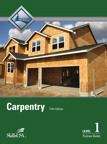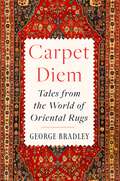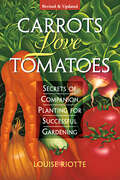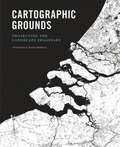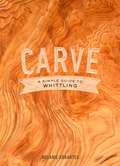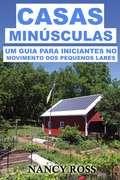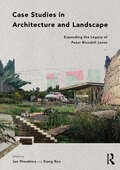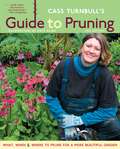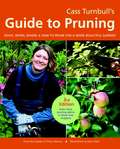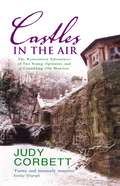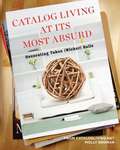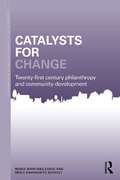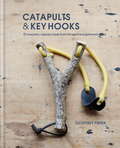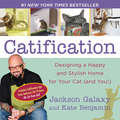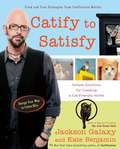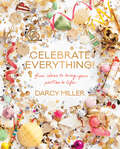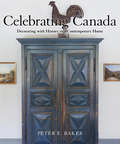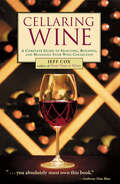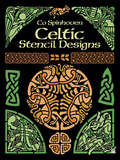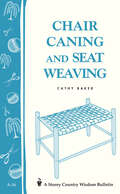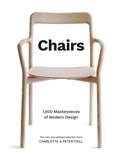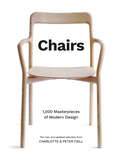- Table View
- List View
Carpentry
by NccerThis exceptionally produced trainee guide features a highly illustrated design, technical hints and tips from industry experts, review questions and a whole lot more! Key content includes: Orientation to the ™ Building Materials, Fasteners, and Adhesives; Hand and Power Tools; Introduction to Construction Drawings, Specifications, and Layout; Floor Systems; Wall Systems; Ceiling Joist and Roof framing; Basic Stair Layout; Introduction to Building Envelope Systems
Carpet Diem: Tales from the World of Oriental Rugs
by George BradleyA colorful tour through the enthralling world of oriental carpets and its unusual characters that is also an honest and often humorous meditation about beautiful objects and our impulse to collect them.One day, the prizewinning poet George Bradley happened to take note of a carpet that had lain beneath his feet for decades. Carefully studying its weave and pattern, he was astonished by its complexity and allure. He became suddenly fascinated, and his newfound curiosity about oriental rugs sent him on a thrilling adventure, introducing him to a little-known realm in which beauty, artistry, business, and history collide.Carpet Diem chronicles Bradley’s exploration of the world of oriental carpets, one in which he falls in love with a variety of captivating rugs and learns about the cultural background of the people who made them. A journey from innocence to experience, this entertaining account includes his encounters with the dealers, collectors, scroungers, restorers, and connoisseurs who inhabit an exotic and sometimes shady milieu. As he brings together his own story with those of these characters, he also tells some of the history of what is one of the world’s great art forms. Like Scheherazade, Bradley spins tale after tale about the sorts of gorgeous textiles found on the floors of mansions across Europe and America, in the portraits of Titian and Vermeer, in the faraway caves of Central Asia, and in bespoke shops of Manhattan, the Hamptons, and Westport, Connecticut.A narrative that combines the mesmerizing storytelling found in The Arabian Nights with the pilgrimage into history that unfolds in The Silk Road and the dramatic compulsion to possess rare elegance that propels The Orchid Thief, Carpet Diem is an unusual and charming memoir that testifies to the intricate beauty woven into our world.Carpet Diem features eleven full-color photographs throughout.
Carrots Love Tomatoes: Secrets of Companion Planting for Successful Gardening
by Louise RiottePlant parsley and asparagus together and you’ll have more of each, but keep broccoli and tomato plants far apart if you want them to thrive. Utilize the natural properties of plants to nourish the soil, repel pests, and secure a greater harvest. With plenty of insightful advice and suggestions for planting schemes, Louise Riotte will inspire you to turn your garden into a naturally nurturing ecosystem.
Carter's Way: A No-Nonsense Method for Designing Your Own Super Stylish Home
by Chris Peterson Carter OosterhouseCarter Oosterhouse knows how real people live and how intimidating home design can be. With his reassuring, “you can do it” attitude, he goes out of his way to show readers how to create realistic design elements that they can implement with basic tools and a little DIY experience. His mission is to bring people’s imaginations to life. The design features he constructs use materials easily found, are budget-conscious, and whenever possible environmentally friendly. In Carter’s Way, he decodes the time-tested principles of design, using specific examples and stunning photos to visually illustrate his points. Each chapter will cover a different area of the house, acknowledging the diversity of layouts in today’s homes. For example, one chapter will focus on spaces for cooking, eating, and socializing to appeal both to people with a formal dining area and those with more open floor plans, with a design that is about comfort, entertaining, and practicality. Other chapters include: intimate bedroom spaces featuring beautiful and efficient storage for a sensual environment that becomes a sanctuary; living/family rooms with the kind of versatility that allows them to convert from game-playing rumpus rooms to elegant cocktail party spaces; luxurious bathrooms that provide a spa-like getaway from stress while also conserving energy and water; home offices/entryways/laundry rooms; and outdoor spaces that can serve as two- or three-season rooms for entertaining and relaxing. [excerpt]I’m writing this book because of all the people who come up to me at events, or write me, saying things like, “I wish I could make my kitchen look like the one on your last show,” or, “If only I could have you work on my living room!” You don’t need me in person. You don’t need anybody else. You need my perspective and my method. My method is what I call “Carter’s Way.” It’s a process that has worked for me in dozens of different rooms and homes. Now I want it to work for you!
Cartographic Grounds: Projecting the Landscape Imaginary
by Charles Waldheim Mohsen Mostafavi Jil DesiminiMapping has been one of the most fertile areas of exploration for architecture and landscape in the past few decades. While documenting this shift in representation from the material and physical description toward the depiction of the unseen and often immaterial, Cartographic Grounds takes a critical view toward the current use of data mapping and visualization and calls for a return to traditional cartographic techniques to reimagine the manifestation and manipulation of the ground itself.Each of the ten chapters focuses on a single cartographic technique--sounding/spot elevation, isobath/contour, hachure/hatch, shaded relief, land classification, figure-ground, stratigraphic column, cross-section, line symbol, conventional sign--and illustrates it through beautiful maps and plans from notable designers and cartographers throughout history, from Leonardo da Vinci to James Corner Field Operations. Mohsen Mostafavi, dean of the Harvard Graduate School of Design, introduces the book.
Carve: A Simple Guide to Whittling
by Melanie AbrantesWhittle a beautiful spoon, comb, pair of dice, and more with this fresh introduction to a folksy craft. Carve modernizes a mindful hobby that people have turned to for generations to help them slow down, relax, and connect with the outdoors. Choose from a dozen projects with bespoke details, all are designed to be useful at home or while camping. And because these objects are small, they require only a few hours and a tool or two to complete. You'll also learn how to choose the right knife and wood, helpful information on techniques and safety, and tips for refining, personalizing and maintaining your piece. Whether you're headed to the woods or just to the porch, this pocket-sized guide will have you carving your own unique designs in no time.From the Hardcover edition.
Casas Minúsculas: Um guia para iniciantes no movimento dos pequenos lares
by Nancy RossDESCUBRA OS BÁSICOS PARA ENTRAR NO MOVIMENTO DAS CASAS MINÚSCULAS, GALINHAS DE QUINTAL, HOMESTEADING E MINI AGRICULTURA TUDO EM UM LIVRO! Aqui está uma prévia do que você vai aprender no primeiro livro ... Os benefícios de casas minúsculas Maneiras de financiar sua pequena casa Encontrando o local perfeito Hacks de fácil espaço para facilitar a vida em casa Idéias De Cozinha Sala de estar, Banheiro, Quartos Design Dicas e truques para entender a minúscula casa, vivendo Muito muito mais! Aqui está uma prévia do que você vai aprender no segundo livro ... Benefícios de galinhas do quintal O que você precisa para começar Obtendo a instalação para trazer as galinhas As melhores raças de quintal Compreender os comportamentos básicos do seu frango Problemas médicos com suas galinhas Ganhar dinheiro com suas galinhas Muito muito mais! Aqui está uma prévia do que você vai aprender no terceiro livro ... As noções básicas de Homesteading Criando seu próprio gado em seu quintal A magia da jardinagem para o seu próprio alimento Preservando sua comida para o inverno Fazendo suas próprias roupas Fazendo seus próprios itens domésticos Muito muito mais! Aqui está uma prévia do que você vai aprender no quarto livro ... Truques simples para maximizar seu espaço Melhores Plantas para Mini Agricultura Escolhendo o solo certo Controle de pragas Cuidar de ervas daninhas Gado que faz bem com Mini agricultura? Dicas para facilitar a criação de minicultura Muito muito mais!
Case Studies in Architecture and Landscape: Expanding the Legacy of Peter Blundell Jones
by Jan Woudstra Xiang RenThe architect, historian and critic Peter Blundell Jones (1949–2016) considered architecture as an expansive field within the arts and humanities and social sciences that included landscape and urban studies. His focus within this built environment was firmly on people and place, which to him meant developing a comprehension of the broad human, material and social engagements with specific localities.His favourite way to explore this human and environmental focus was through case studies of individual places, leading to a modus operandi to tackle the study of any place in a generous, rigorous and comprehensive manner that used the skills of related professions, of the sciences as well as of psychology and anthropology. Being able to adopt such interdisciplinarity determined the real value of his output, which was further enriched through the thick interpretation of placemaking in non-Western cultures.This book, celebrating the East-West Studies in Architecture and Landscape at the University of Sheffield co-founded by Peter Blundell Jones in 1995, presents 16 distinctive case studies in order to underline the relevance of his case study methodology and global legacy. It is intended to have relevance for a range of disciplines including the design ones of architecture, landscape and urban design and planning, as well as anthropology, history, geography and cultural studies.
Cass Turnbull's Guide to Pruning, 2nd Edition
by Cass TurnbussNothing about pruning is obvious; in fact, most of it is downright counterintuitive, says expert Cass Turnbull. This second edition of her definitive illustrated guide adds 40 percent new material, with more coverage of different kinds of trees, shrubs, and ground covers and how to prune them for health and aesthetics. The book is organized around the most common types of plants found in Northwest gardens: evergreen and deciduous shrubs; bamboos and tea roses; rhododendrons, camellia and other tree-like shrubs; hedge plants like boxwood and heather; clematis, wisteria and all those vines; and detailed information on trees by species from dogwoods to weeping cherries. In her trademark witty style, Turnbull also addresses tools, landscape renovation, and design errors. Included too are her amusing Ten Commandments for gardeners, which feature such treasures as "Thou shalt not weed-whip the trunk of thy tree, nor bash it with thine mower, nor leave anything tied on thy tree or the branches of thy tree, as is done in the land of the philistines."
Cass Turnbull's Guide to Pruning, 3rd Edition: What, When, Where, and How to Prune for a More Beautiful Garden
by Cass TurnbullThis 3rd Edition of Cass Turnbull's Guide to Pruning covers more than twenty additional plants in three new chapters. The result is the new definitive guide for the home gardener with friendly, expert advice from Cass Turnbull, founder of Seattle's PlantAmnesty, whose mission is "to end the senseless torture and mutilation of trees and shrubs caused by mal-pruning."Nothing about pruning is obvious. In fact, most of it is downright counterintuitive. People try to prune plants like they cut lumber or hair. But that doesn't work to get what they want. Your plants are actually telling you how they want to be pruned and where they need to be planted, if you would just learn to listen to your burning bush. Here are ten commandments for preventing mal-pruning and other gardening sins:The Ten Gardener Commandments1. Thou shalt not shear thy bush.2. Thou shalt not top thy tree.3. Thou shalt not plant thy sun-lover in the shade, nor thy shade-lover in the sun.4. Thou shalt mulch.5. Thou shalt not leave stubs.6. Thou shalt not flush cut, neither shalt thou paint wounds.7. Thou shalt not cover up the base of thy plant, or thy tree, or thy shrub. Neither with mulch, nor with soil, nor with any landscape material.8. Thou shalt cut circling/girdling roots.9. Thou shalt not compact the root zone of thy tree, nor trench near the trunk of thy tree.10. Thou shalt not weed-whip the trunk of thy tree, nor bash it with thine mower, nor leave anything tied on thy tree or the branches of thy tree, as is done in the land of the philistines.With the information in Cass Turnbull's Guide to Pruning, you can approach your trees, shrubs, and other plants with the knowledge that will make your plants grow in healthy and aesthetic ways. The book is organized around the most common types of plants found in Northwest gardens: evergreen and deciduous shrubs; bamboos and tea roses; rhododendrons, camellia, and other tree-like shrubs; hedge plants like boxwood and heather; and clematis, wisteria, and all those vines. It also includes detailed information on trees by species from dogwoods to weeping cherries.Cass Turnbull is a gardner with a mission, so mind your shears and loppers!
Castles In The Air: The Restoration Adventures of Two Young Optimists and a Crumbling Old Mansion
by Judy CorbettCastles in the Air is a beautifully written, autobiographical story of rescuing an ancient mansion. Gwydir Castle was inhabited by ravers and rats until Judy Corbett and her husband Peter Welford found and acquired this 500-year-old house mouldering in the foothills of Snowdonia. Despite the toads, strange smells and squatters, they decided to mortgage themselves to the hilt to bring the castle back to life.This is an evocatively written and genuinely moving book and is infused with an extraordinary sense of place. The couple's adventures in a gothic wonderland lead them through plots both supernatural and historical. In a museum storeroom in a Bronx warehouse they find a missing room, in the castle's Solar Tower the ghost of a young woman appears and from the far edges of the woods a silent man called Sven emerges to befriend the couple and their beloved castle.For everyone who has ever wanted to live in a glorious house or escape from the mundanity of life - Castles in the Air is pure magic.
Catalog Living at Its Most Absurd
by Molly ErdmanMillions have already been to Gary and Elaine's. Isn't it time you dropped by? Have you ever flipped through the pages of a Pottery Barn catalog and thought, "Who actually lives that way?" Rest assured, you are not alone. Pushed too far by a photo depicting a plate of figs placed under a table, actor and Second City-alum Molly Erdman created Gary and Elaine, a well-heeled and deeply superficial couple living happily amongst abundantly pillowed chairs, giant abacuses, and decorative fruit. Inspired by Erdman's popular blog Catalog Living, Decorating Takes (Wicker) Balls takes home décor catalog photos and sends them up with wickedly funny captions mockumenting Gary and Elaine, their lives, and their absurdly over-decorated rooms. Praise for www.catalogliving.net:"'Catalog Living'" taps into thoughts many have had ... about how things are sold to us." --Chicago Tribune
Catalysts for Change: 21st Century Philanthropy and Community Development (Community Development Research and Practice Series)
by Maria Martinez-Cosio Mirle Rabinowitz BussellWinner of the Community Development Society's 2014 Current Research Award! 21st Century Philanthropy and Community fills a gap in the literature on philanthropic organizations and how they intertwine with community development. Drawing first on the history of philanthropic funding, Maria Martinez-Cosio and Mirle Bussell look at developments in the last twenty years in detail, focussing on five key case studies from across America. The authors use their own first hand experiences and research to forge a new path for academic research in an area where it has been lacking. With the current economic climate forcing shrewd spending, foundations need all the guidance they can find on how to appropriately channel their funds in the best way. But how can these sorts of community projects be analyzed for effectiveness? Is there a quantitative rather than qualitative element which can be studied to give real feedback to those investing in projects? Arguing against a one-size-fits-all model, the authors illustrate the importance of context and relationships in the success of these projects.
Catapults & Key Hooks: Everyday objects made from foraged and gathered wood
by Geoffrey FisherWhether building a bee hotel to help your garden's ecosystem thrive, crafting a catapult, whistle, skipping rope or cup and ball game to give away, or making a key hook or cobweb brush to organise your home, the result of each will be entirely unique while also effortlessly stylish.All basic woodworking techniques are covered, plus Geoffrey also shows how best to prepare materials, including checking for disease, drying and stripping bark, and gives a detailed guide on your essential tool kit - what to have, how to handle your tools safely and how to maintain everything to the highest standard -meaning anyone can pick up Catapults & Key Hooks and dive straight into the world of Geoffrey's designs.
Catfish Ponds & Lily Pads: Creating and Enjoying a Family Pond
by Louise RiotteIn this entertaining guide, Louise Riotte tells you everything you need to know to create a productive pond on your own land, from siting the pond to maintaining water quality and stocking the pond with fish. She also includes plenty of old-time fishing lore and scrumptious recipes for freshly caught fish.
Catification: Designing a Happy and Stylish Home for Your Cat (and You!)
by Jackson Galaxy Kate BenjaminThe star of Animal Planet's hit television series My Cat from Hell, Jackson Galaxy, shows cat owners everywhere how to make their homes both cat-friendly and chic. Cat owners know the struggles of creating living spaces that are both functional and stylish for owner and cat. Don't just go to your local pet shop and adorn your home with unattractive cat towers and kitty beds. In Catification, Jackson Galaxy, the star of Animal Planet's My Cat from Hell, and Kate Benjamin, of the popular cat design website Hauspanther.com, walk readers through a step-by-step process of designing an attractive home that is also an optimal environment for cats. This gorgeously designed, full-color book includes more than twenty fun DIY projects, from kitty beds and litter boxes to catios (cat patios) that will be sure to make readers--and their cats--purr in approval.
Catify to Satisfy
by Jackson Galaxy Kate BenjaminIn this book, Jackson Galaxy, star of Animal Planet's hit show My Cat from Hell, and Kate Benjamin, cat design wizard, show cat guardians everywhere how to use home design tricks to address everyday cat care issues. Does your feline friend like to pee everywhere but in his or her litter box? Does your kitty have a thing for your furniture that has left your beloved couch in tatters? Catify to Satisfy will show you how simple DIY design projects and hacks can help bring harmony back into your home. Featuring the amazing projects cat guardians from around the world have shared with Jackson and Kate--design strategies for solving even the most daunting kitty challenges--this book is the ultimate guide to creating a happy home for cat guardian and cat alike.From the Trade Paperback edition.
Celebrate Everything!: Fun Ideas to Bring Your Parties to Life
by Darcy MillerThe ultimate guide to making special occasions unforgettable, by celebrations expert Darcy Miller, the founding editor of Martha Stewart Weddings.
Celebrating Canada: Decorating with History in a Contemporary Home
by Peter E. Baker John A. FlemingA visual journey showcasing how history can make a house a home, a reminder of the strength of character and ingenuity entrenched in Canada’s history. Inspired by the 150th anniversary of Canadian confederation — the same year recognizing 375 years of settlement in Montreal — Quebec antiques professional Peter E. Baker brings life to Canadian history and demonstrates how antiques and folk art can successfully be incorporated into a contemporary lifestyle, providing a home with a unique identity. Drawing from a single collection, the author selects and showcases objects spanning three centuries of Canadian history, from the early days of French settlement to the creative boom of late-20th-century folk artists. Amply illustrated, and written in a conversational, easy-to-read style, this is not a traditional technical study of antiques representing a specific type or region. Celebrating Canada showcases the story and the artistic merits of each object.
Cellaring Wine: A Complete Guide to Selecting, Building, and Managing Your Wine Collection
by Jeff CoxEnjoy the rich and complex flavors of wine that’s been matured to its peak. In this comprehensive guide, Jeff Cox provides everything you need to know to build and maintain your own wine cellar. Whether you’re thinking of storing a few extra bottles in a spare closet or are looking to properly age a garage full of wine, you’ll find straightforward advice and helpful hints on successful cellaring techniques. Build and delight in your collection of wine while learning how to bring out the full potential of every bottle.
Celtic Stencil Designs
by Co SpinhovenWith great skill and flair, Dutch artist Co Spinhoven has translated the stirring imagery of traditional Celtic art into a collection of 130 exciting and versatile stencil designs. With them, graphic artists and craftspeople can bring to their work the distinctive beauty and drama of a great decorative arts tradition. The designs, all copyright-free, are derived from the Book of Kells and other early medieval Celtic sources. Their themes range from birds and beasts of myth and scripture to elegantly wrought abstract motifs. The designs vary widely in size, shape, and complexity. They range from large and elaborate squares, circles, and rectangles to elongated border motifs to minimal design accents. Co Spinhoven has adapted each of them admirably to the technical requirements of stencil painting. Graphic artists, textile designers, and many others in the arts and crafts will find these sturdy, reusable stencils indispensable for adding - quickly and easily - authentic touches of Celtic imagery to their projects.
Chair Caning and Seat Weaving: Storey Country Wisdom Bulletin A-16 (Storey Country Wisdom Bulletin Ser.)
by Cathy BakerSince 1973, Storey's Country Wisdom Bulletins have offered practical, hands-on instructions designed to help readers master dozens of country living skills quickly and easily. There are now more than 170 titles in this series, and their remarkable popularity reflects the common desire of country and city dwellers alike to cultivate personal independence in everyday life.
Chairs: 1,000 Masterpieces of Modern Design, 1800 to the Present Day
by Peter Fiell Charlotte FiellFrom Alvar Aalto to Marco Zanuso, Chairs introduces over 1,000 groundbreaking innovations by the world's greatest designers. Tracing the history of the modern chair from 1800 to the present day, revered experts Charlotte and Peter Fiell comprehensively guide you through the fascinating world of seating design – from the functional office chair to the limited edition art piece.With more than 1,000 exquisite images alongside fascinating insights into the conception, design and production of these masterpieces, this definitive collection includes design classics such as Josef Hoffmann's Sitzmaschine, Robin Day's Polyprop and computer-generated masterworks by Zhang Zhoujie, amongst many more.
Chairs: 1,000 Masterpieces of Modern Design, 1800 to the Present Day
by Peter Fiell Charlotte FiellThis updated edition features designs from 1800 up to present day, and features the biggest names in furniture design, art, architecture and craft.
Chairs: 1,000 Masterpieces of Modern Design, 1800 to the Present Day
by Peter Fiell Charlotte FiellThis updated edition features designs from 1800 up to present day, and features the biggest names in furniture design, art, architecture and craft.
